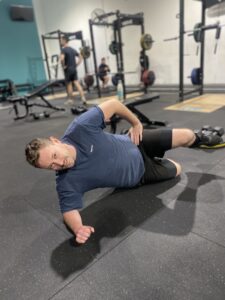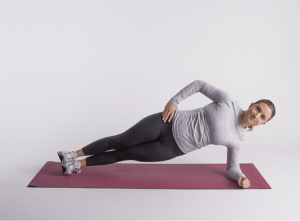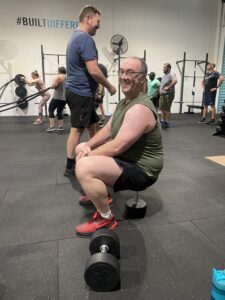As we age, maintaining a strong core becomes increasingly crucial for overall health and fitness. Core exercises are not just about achieving a flat stomach; they play a vital role in improving posture, reducing back pain, and enhancing balance. For those over 40, focusing on core strength has an impact on everyday activities, from carrying groceries to playing with grandchildren.
This article will explore seven essential core exercises tailored for individuals over 40. We’ll delve into the importance of core strength as we age, discuss various plank variations to build a solid foundation, and introduce dynamic core exercises to challenge your muscles. Additionally, we’ll provide guidance on how to incorporate these exercises into your routine effectively. By the end, you’ll have a comprehensive understanding of how to maintain and improve your core strength after 40.

The Importance of Core Strength After 40
As we enter our 40s and beyond, maintaining a strong core becomes increasingly crucial for overall health and well-being. Core strength has an impact on various aspects of our daily lives, from performing everyday tasks to enjoying physical activities. Let’s explore why core strength is so important after 40 and how it can benefit us in multiple ways.
Improved balance and stability
One of the key benefits of a strong core is its effect on balance and stability. As we age, our body’s ability to maintain balance naturally declines, which can increase the risk of falls and injuries. A solid core acts as the foundation for our entire body, helping us stay steady on our feet.
Core strengthening exercises improve our body’s proprioception – the awareness of our body’s position in space. This enhanced body awareness allows us to react more quickly to sudden changes in our environment, reducing the likelihood of falls. For older adults, this is particularly important as falls can lead to serious injuries and complications.
Moreover, a strong core helps distribute our body weight evenly across our skeletal structure. This even distribution not only improves our balance but also reduces strain on our muscles and joints, making it easier to perform daily activities with greater ease and confidence.
Better posture

Poor posture is a common issue as we age, often resulting from weakened core muscles and bad habits developed over time. A strong core plays a vital role in maintaining good posture, which has a significant impact on our overall health and appearance.
When our core muscles are weak, we tend to slouch, which can lead to a range of problems including back pain, neck strain, and shoulder discomfort. By strengthening our core, we provide better support for our spine, helping us stand taller and straighter.
Good posture not only makes us look more confident but also has several health benefits. It allows us to breathe more deeply, which can improve our overall energy levels and reduce fatigue. Additionally, proper alignment of our spine and other joints can help minimise wear and tear, potentially reducing the risk of developing chronic pain conditions.
Reduced risk of injury
A strong core acts as a protective shield for our body, significantly lowering the risk of injuries, especially those related to the lower back. As we age, our muscles naturally lose strength and mass, a condition known as sarcopenia. This loss of muscle can make us more susceptible to injuries during everyday activities or exercise.
By focusing on core strength, we can counteract some of these age-related changes and build a more resilient body. A strong core provides stability to our spine and pelvis, which is crucial for preventing lower back pain – a common complaint among older adults.
Furthermore, a solid core foundation allows us to perform various movements more efficiently and safely. Whether it’s lifting groceries, playing with grandchildren, or engaging in sports activities, a strong core helps us maintain proper form and technique, reducing the strain on other parts of our body.
In essence, core strength after 40 is not just about achieving a flat stomach; it’s about building a strong foundation for a healthier, more active lifestyle. By incorporating core exercises into our routine, we can improve our balance, enhance our posture, and lower our risk of injuries, allowing us to enjoy our daily activities with greater ease and confidence.
Plank Variations for a Strong Core

Planks are a fantastic way to build core strength, especially for those over 40. They offer a range of benefits, including improved posture, reduced risk of back pain, and enhanced overall stability. Let’s explore some effective plank variations that can help you achieve a stronger core.
Standard plank
The standard plank is a fundamental exercise that targets multiple muscle groups simultaneously. To perform a standard plank:
- Start on all fours with your hands directly under your shoulders, slightly wider than shoulder-width apart.
- Extend your legs behind you, grounding your toes into the floor.
- Engage your core and squeeze your glutes to stabilise your body.
- Keep your neck neutral by looking at a spot on the floor about a foot beyond your hands.
- Hold this position for 30 to 60 seconds, depending on your fitness level.
As you become more comfortable with the exercise, try to hold the plank for longer periods without compromising your form or breath. Remember, proper form is crucial for getting the most out of this exercise and avoiding injury.
Side plank
The side plank is an excellent variation that targets your obliques, the muscles along the sides of your core. This exercise also helps improve balance and stability. Here’s how to do a side plank:
- Lie on your side with your legs straight and feet stacked.
- Place your elbow directly under your shoulder, with your forearm flat on the ground.
- Lift your hips off the mat, creating a straight line from your ankles to your head.
- Hold this position for 15 to 30 seconds, then switch sides.
For beginners, you can modify the side plank by bending your bottom knee and resting it on the ground for additional support. As you build strength, try lifting your top leg or arm to increase the challenge.
Forearm plank
The forearm plank is a variation that puts less stress on your wrists while still providing an intense core workout. To perform a forearm plank:
- Start by lying face down on the floor.
- Place your forearms on the ground, elbows directly under your shoulders.
- Extend your legs behind you, toes tucked under.
- Lift your body off the ground, creating a straight line from head to heels.
- Engage your core and keep your hips in line with your shoulders.
- Hold this position for 20 to 30 seconds, gradually increasing the duration as you build strength.
To maximise the effectiveness of the forearm plank, try these cues:
- Tuck your tailbone slightly under while squeezing your glutes.
- Gently pull your elbows towards your toes to engage your abs more.
- Keep your shoulders stacked over your elbows and press the floor away from you.
Remember, quality is more important than quantity when it comes to planks. Focus on maintaining proper form throughout the exercise, even if it means holding the position for a shorter duration. As you progress, you can increase the hold time or try more challenging variations to continue building your core strength.
Dynamic Core Exercises
Dynamic core exercises are a crucial component of any well-rounded fitness routine, especially for those over 40. These exercises involve movement and engage multiple muscle groups simultaneously, providing a more functional workout that mimics real-life activities. Let’s explore three effective dynamic core exercises that can help you build strength and improve stability.
Mountain climbers

Mountain climbers are a fantastic full-body exercise that targets your core, shoulders, arms, and legs. This exercise not only strengthens your muscles but also provides a cardiovascular workout, making it an excellent choice for those looking to improve their overall fitness.
To perform mountain climbers:
- Start in a high plank position with your hands shoulder-width apart.
- Keep your body in a straight line from head to heels.
- Bring your right knee towards your chest, then quickly switch legs, bringing the left knee forward while extending the right leg back.
- Continue alternating legs in a running motion.
As you become more comfortable with the exercise, you can increase your speed to make it more challenging. Remember to keep your core engaged throughout the movement to maintain proper form and maximise the benefits.
Russian twists
Russian twists are an effective exercise for targeting your obliques and improving rotational strength. This movement helps enhance your ability to twist and turn, which is essential for many daily activities and sports.
To perform Russian twists:
- Sit on the floor with your knees bent and feet flat on the ground.
- Lean back slightly, keeping your spine straight, and lift your feet off the floor.
- Clasp your hands together in front of your chest.
- Rotate your torso to the right, then to the left, keeping your core engaged throughout the movement.
As you progress, you can add a weight or medicine ball to increase the difficulty. Focus on maintaining proper form and moving slowly to get the most out of this exercise.
Bicycle crunches
Bicycle crunches are an excellent exercise for targeting multiple areas of your core, including your rectus abdominis, obliques, and hip flexors. This dynamic movement also helps improve coordination and balance.
To perform bicycle crunches:
- Lie on your back with your hands behind your head and your legs extended.
- Lift your shoulders off the ground and bring your right elbow towards your left knee while extending your right leg.
- Switch sides, bringing your left elbow towards your right knee while extending your left leg.
- Continue alternating sides in a pedalling motion.
Remember to keep your lower back pressed against the floor throughout the exercise to protect your spine. Focus on the quality of your movements rather than speed to get the most benefit from this exercise.
Incorporating these dynamic core exercises into your routine can help you build a stronger, more stable core. Start with 2-3 sets of 10-15 repetitions for each exercise, gradually increasing the number of reps and sets as you build strength and endurance. Always listen to your body and adjust the intensity as needed to avoid strain or injury.
Incorporating Core Exercises into Your Routine
Integrating core exercises into your fitness routine is crucial for maintaining strength and stability, especially after 40. To get the most out of your core workouts, it’s important to consider the frequency, duration, proper form, and progression of your exercises.
Frequency and duration
To see real benefits, aim to do core exercises two to three times a week. This frequency allows for adequate recovery time while still providing consistent stimulation to your core muscles. Start with short sessions of about 5-10 minutes and gradually increase the duration as your strength and endurance improve.
It’s not necessary to dedicate long periods to core work. In fact, you can sprinkle in core exercises throughout your day. Look for opportunities to do short bursts of exercises or stretches a few times daily. This approach can be particularly helpful if you’re just starting out or have a busy schedule.
Proper form and technique
Maintaining proper form is crucial when performing core exercises. This ensures you target the right muscles and minimise the risk of injury. When doing exercises like planks or bridges, focus on keeping your body in a straight line from head to heels. Engage your core by imagining you’re pulling your belly button towards your spine.
For exercises like crunches, avoid pulling on your neck. Instead, place your hands behind your head or cross them over your chest. Remember to breathe steadily throughout each exercise, as holding your breath can increase pressure on your core and potentially lead to strain.
Progression and variation
As you build strength, it’s important to progressively challenge your core muscles. Start with basic exercises and gradually move on to more advanced variations. For example, you might begin with a standard plank and progress to a side plank or a plank with leg lifts.
Varying your exercises is also key to preventing boredom and ensuring you target all aspects of your core. Mix stability exercises with dynamic movements to create a well-rounded routine. This could include a combination of planks, bridges, bicycle crunches, and Russian twists.
Remember, consistency is more important than intensity when it comes to core training. Start slowly, focus on proper form, and gradually increase the challenge as you build strength and confidence. By incorporating these principles into your routine, you’ll be on your way to a stronger, more stable core.
Conclusion
Building a strong core after 40 has a significant impact on overall health and well-being. The exercises discussed in this article provide a solid foundation to enhance core strength, improve balance, and boost posture. By incorporating these movements into your routine, you’re taking a crucial step to maintain an active and healthy lifestyle as you age.
Remember, consistency is key when it comes to core training. Start slowly, focus on proper form, and gradually increase the challenge as you build strength and confidence. By doing so, you’ll be on your way to a stronger, more stable core, which will benefit you in countless ways in your daily life. So why wait? It’s time to get started on your journey to a stronger core and a healthier you.
Ready to get started on building a strong and healthy body? CLICK HERE to schedule a time to speak with one of our friendly trainers!
For our other free BLOG articles CLICK HERE.
To listen to The Performance Hub Podcast CLICK HERE.
To learn more about our services at The Performance Hub CLICK HERE.



